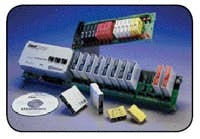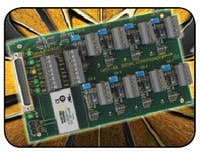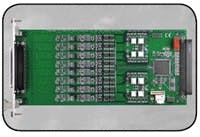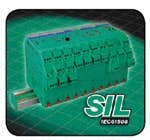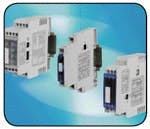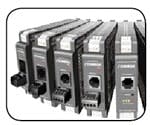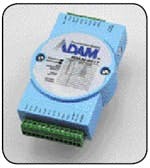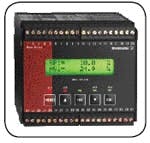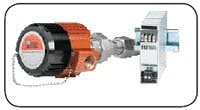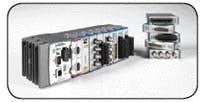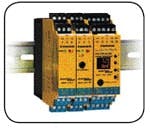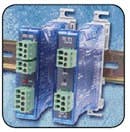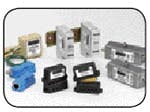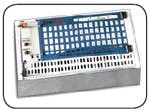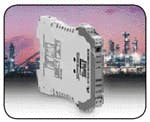By Patti pool, new products editor
We need signal conditioners to ensure that sensor accuracy, transmission and signal type are compatible with the rest of the control system. Signal conditioners are the workhorses in control systems that enable system accuracies that cant be achieved in any other way. For instance, they perform conversion, isolation, amplification, filtering and linearization of analog sensor signals.
So, how do we make signal conditioners simple to use? One avenue to take is plug-and-play, commonly known as a transducer electronic data sheet (TEDS). Standard P1451.4 is the most recent addition to IEEEs family of smart transducer interface standards. P1451.4 provides a relatively simple mechanism for building plug-and-play into traditional analog sensors.
The standard specifies the format and content of self-identifying parameters stored in the TEDs. The standard also defines two mixed-mode interfaces, analog and digital, that will enable various types of automatic sensing systems to access the sensors self-identification data.
A number of manufacturers have included P1451.4-compliant TEDS on their sensors for several years. Sensor data are thus electronically available for interrogation, and signal conditioners have been adapted to do that interrogation.
Plug-and-play eliminates the need to read and enter data from a paper calibration sheet. The calibration sheet stays with the sensor.
Theres also no cable confusion. Plug-and-play technology enables the signal conditioner to read a sensors type and calibration information, as well as tell you exactly where your sensor is located.
With a TEDS sensor that automatically provides calibration data to an active signal conditioner, a technician unfamiliar with calibration procedures can swap a sensor quickly without hurting the integrity of the system operation.
Burning location data onto each sensors TEDS will help you to inventory your sensorsgreat for large installations where looking for the right sensor could be a headache.
Plug-and-play implemented according to P1451.4 makes plugging sensors from one manufacturer into signal conditioners from another much easier for the end user.
Enhanced version of the SCM5B48 isolated and field-configurable accelerometer input signal conditioning module provides excitation to piezoelectric sensors with built-in microelectronic amplifiers, commonly known as ICP, IEPE or LIVM sensors. The module provides a constant current excitation to the sensor and then isolates, filters and amplifies the sensor output, yielding a high-level analog voltage output. The excitation current, signal gain and filter high-pass and low-pass cutoff frequencies are field-configurable through a set of switches. Dataforth; 520/741-1404; dataforth.com
Model LVDT-8A signal conditioner board offers eight channels of signal conditioning on one board, providing enhanced capability of simultaneous outputs that directly correspond to the sensed positions in a real-time environment. Use the board in factory automation environments such as machining, inspection, automotive and weighing.
Acces I/O Products; 858/550-9559; accesio.com
MSXB 078 digital I/O expansion hardware combines simultaneous operation on all channels with an isolated ground to protect your application ground currents. It provides 16 digital inputs and 16 digital outputs on an HD62 connector, with headers for alternate connectors. Eight MSXB 078 boards connected to a single DAP board provide 128 digital inputs and 128 digital outputsall operating simultaneously and with a ground isolated from the PC.
Microstar Laboratories; 425/453-2345; mstarlabs.com
K-System modular components provide signal transfer protection between field devices and control systems and conform to SIL ratings. High-density, intrinsically-safe isolators for hazardous areas, signal conditioners for non-hazardous areas, limit alarms and logic controls come in one housing style, and keyed removable terminals ensure proper connection. Modules mount in any orientation to panels, DIN rails, motherboards, or to this companys PowerRail.
Pepperl+Fuchs; 330/486-0002; am.pepperl-fuchs.com
JumpFlex Series 857 6-mm-wide, DIN-rail mount signal conditioning and relay modules include 12 different typesboth configurable and dedicated. Signal types supported include current, voltage, HART protocol, RTDs and thermocouples. Configurations include splitter, single and multi-channel, repeater, and loop-powered modules. Configurable modules are programmed via dipswitch (for current, voltage and temperature) and/or FDT/DTM software (temperature only). They have pre-marked modules for easy circuit identification, marking tag holder for module identification and built-in indication for power or signal status.
Wago; 262/255-6222; wago.us
DIN-rail-mounted analog converters and isolators, RTD and thermocouple converters, analog to frequency signal converters, and threshold modules come as narrow as 6 mm. Options include programmable multi-function units or single-input/single-output models. Units use 24 Vdc supply or a range of input models that operate off of 24-240 Vac/Vdc. Accuracy is 0.1%.
Automated Systems Interconnect (ASI); 877/650-5160; asi-ez.com
iD Series signal conditioners mount on a 35-mm DIN-rail and operate 1032 Vdc. A matching 24 Vdc/850 mA switching power supply is available. The devices have three-way isolation to 1,800 Vdc between the signal inputs, outputs and power supply, and are CE compliant.
Omega Engineering; 203/359-1660; omega.com
Adam-6017 has eight analog inputs and two digital outputs, and each analog channel can configure an individual range. It has 10/100 Mbps communication rate, default/customized web page, math functions and supports mV, V, mA input types.
Advantech, Industrial Automation Group; 513/742-8895; eautomationpro.com/us
Analog system adapter for MINI MCR isolators and connectors is designed to reduce wiring time. Users plug in the system cables directly from the analog isolators or converters, and into the controllers, reducing wiring and human error. The adapters have a wide range of certifications and can be used in Ex Zone 2 environments.
Phoenix Contact; 800/888-7388; phoenixcon.com
Multiplus configurable process monitoring modules for applications requiring customized multi-channel measurements, isolation, linearization, math functions and serial communications have an eight-channel and four-channel version. AI8 accepts DC voltage or current inputs; the AI4 accepts platinum, nickel or copper RTD inputs. Both can be custom-configured via front panel pushbuttons to provide outputs from a built-in suite of single and multi-variable options.
Weidmüller; 804/794-2877; weidmuller.com
THZ (2) and TDZ (2) loop-powered (two-wire) smart HART signal conditioners can be configured from any point on the twisted wire pair to accept 0-50 mA, 0-10 V, resistance, potentiometer and millivolt signal inputs, as well as RTD and thermocouple types. The devices deliver an isolated (up to 1,500 Vrms), 4-20 mA output ready for direct interface with HART or non-HART based DCS, PLC and other computer-based systems.
Moore Industries-International; 818/894-7111; miinet.com
Suite of software and hardware intellectual property (IP) makes using field-programmable gate arrays (FPGAs) in measurement, control and signal processing applications easier. FPGA IPNet provides an open forum for sharing LabView FPGA IP and new hardware I/O modules for analog and digital I/O, communication buses/protocols and motion control.
National Instruments; 888/280-7645; ni.com
IM34 temperature converting device converts a two-, three-, or four-wire RTD, mV signal or TC in a hazardous area to an analog 4-20 mA signal in a non-hazardous area. This pushbutton or software (FDT/DTM, free shareware) configurable unit allows several different input types to be configured and used with common 4-20 mA analog input control cards.
Turck; 800/544-7769; turck-usa.com
FC-11 is a loop-powered signal conditioner and isolator for 4-20 mA signals. FC-33 is a DC-powered selectable signal conditioner and isolator for voltage/current signals with pushbutton programmable ranges and LED indicators. FC-Ti provides conditioning, isolation and cold-junction compensation for thermocouples/mV inputs. FC-R1 is a loop-powered signal conditioner for RTD signals with selectable inputs for Pt100, Pt1000 and Cu100.
AutomationDirect; 770/889-2858; automationdirect.com
STC Series data/signal line surge protection devices, in a variety of application-specific voltages and packaging configurations, prevent transient voltages from interrupting data streams or damaging vulnerable electronic equipment. Multi-stage, hybrid circuitry based on gas tubes, silicon avalanche components and resettable PTC fuses address over-voltage transients to provide high-speed, high-energy protection to network signal lines entering or leaving control panels.
Sola/Hevi-Duty; 800/377-4384; solaheviduty.com/
DTX-5000 programmable signal conditioning system has a multiple 5U chassis that can be Ethernet linked for high channel requirements. The unit runs on Windows, has a graphical user interface, and provides interconnections for both discrete outputs and DataMax recorder interconnections. Each channel has a 16-bit analog-to-digital converter and a digital signal processor. Plug-in modules are available for process variable measurements.
R.C. Electronics; 805/685-7770; rcelectronics.com
LVC-2500 DC-LVDT signal conditioner offers bipolar 0-10 Vdc, unipolar 24 Vdc, or 4-20 mA (sourcing) analog outputs. Users choose between 3, 5, or 10 kHz nominal excitation frequencies at 3 Vrms. Modules can be connected in master/slave mode to synchronize excitation oscillator frequency. Front-panel, externally accessible span and zero controls allow output offset adjustment ±100% of full-scale output.
Macro Sensors; 856/662-8000; macrosensors.com
Wait for the Signal
WV408 DC voltage/current input isolating signal conditioner and WV428 thermocouple input isolating signal conditioner can be installed directly in the Class I, Div 2 (Groups A, B, C and D) hazardous locations. It includes Smart Power, which eliminates wasted power for low-loop-resistance loads in the current output mode; has enhanced diagnostic LEDs; comes with compact DIN-rail-mount housing; and is CE and CSA approved and UL recognized.
Invensys/Eurotherm; 703/669-1324; eurotherm.com

Leaders relevant to this article:

